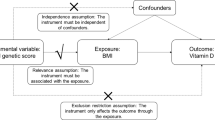Abstract
Objectives
Vitamin D deficiency was associated with obesity. However, the causal relationship remains controversial. We hypothesized that there would be family-based associations in both vitamin D deficient families and obese families for the SNPs associated with vitamin D deficiency, if vitamin D deficiency was a causal factor of obesity. We aimed to investigate the family-based association of SNPs in CYP27B1 with both vitamin D deficiency and obesity.
Methods
Four hundred and nineteen pedigrees containing 1505 rural individuals aged from 18 to 79 years in Henan Province of China were included in this study. Family-based associations of rs10877012 and rs4646536 in CYP27B1 with vitamin D deficiency and obesity were investigated. Serum 25(OH)D3 concentration <20 μg/L was defined as vitamin D deficiency. BMI ≥ 28 kg/m2 was applied for obesity definition. Taqman assays were applied for SNP genotyping. Family-based associations were investigated with FBAT software.
Results
It was shown that vitamin D deficiency was a risk factor of obesity (adjusted OR: 1.332, 95% CI: 1.042–1.703, P = 0.022). Furthermore, there were family-based associations for allele T of rs10877012 and allele T of rs4646536 in both vitamin D deficient families and obese families (P < 0.05). Both rs10877012 and rs4646536 were associated with serum 25(OH)D3 levels between siblings (P < 0.05), but not BMI (P > 0.05). In addition, there is linkage disequilibrium between rs10877012 and rs4646536 (D′ = 1.0, r2 = 0.992).
Conclusion
Vitamin D deficiency may be a causal factor of obesity. Maintaining sufficient vitamin D is beneficial to obesity prevention.
This is a preview of subscription content, access via your institution
Access options
Subscribe to this journal
Receive 12 print issues and online access
$259.00 per year
only $21.58 per issue
Buy this article
- Purchase on Springer Link
- Instant access to full article PDF
Prices may be subject to local taxes which are calculated during checkout

Similar content being viewed by others
References
Pereira-Santos M, Costa PRF, Assis AMO, Santos CAST, Santos DB. Obesity and vitamin D deficiency: a systematic review and meta-analysis. Obes Rev. 2015;16:341–9. https://doi.org/10.1111/obr.12239.
Wortsman J, Matsuoka LY, Chen TC, Lu Z, Holick MF. Decreased bioavailability of vitamin D in obesity. Am J Clin Nutr. 2000;72:690–3.
Wood RJ. Vitamin D and adipogenesis: new molecular insights. Nutr Rev. 2008;66:40–46. https://doi.org/10.1111/j.1753-4887.2007.00004.x.
Bahrami A, Sadeghnia HR, Tabatabaeizadeh SA, Bahrami-Taghanaki H, Behboodi N, Esmaeili H, et al. Genetic and epigenetic factors influencing vitamin D status. J Cell Physiol 2018;233:4033–43. https://doi.org/10.1002/jcp.26216.
Orton SM, Morris AP, Herrera BM, Ramagopalan SV, Lincoln MR, Chao MJ, et al. Evidence for genetic regulation of vitamin D status in twins with multiple sclerosis. Am J Clin Nutr. 2008;88:441–7.
Zhou BF. Effect of body mass index on all-cause mortality and incidence of cardiovascular diseases–report for meta-analysis of prospective studies open optimal cut-off points of body mass index in Chinese adults. Biomed Environ Sci. 2002;15:245–52.
Signorello LB, Shi JJ, Cai QY, Zheng W, Williams SM, Long JR et al. Common variation in vitamin D pathway genes predicts circulating 25-hydroxyvitamin D levels among African Americans. PloS ONE. 2011;6. https://doi.org/10.1371/journal.pone.0028623.
Bailey R, Cooper JD, Zeitels L, Smyth DJ, Yang JHM, Walker NM, et al. Association of the vitamin D metabolism gene CYP27B1 with type 1 diabetes. Diabetes. 2007;56:2616–21. https://doi.org/10.2337/db07-0652.
Martini LA, Wood RJ. Vitamin D status and the metabolic syndrome. Nutr Rev. 2006;64:479–86. https://doi.org/10.1301/nr.2006.nov.479-486.
Mutt SJ, Hypponen E, Saarnio J, Jarvelin MR, Herzig KH. Vitamin D and adipose tissue-more than storage. Front Physiol. 2014;5. https://doi.org/10.3389/Fphys.2014.00228.
Salehpour A, Hosseinpanah F, Shidfar F, Vafa M, Razaghi M, Dehghani S et al. A 12-week double-blind randomized clinical trial of vitamin D-3 supplementation on body fat mass in healthy overweight and obese women. Nutr J. 2012;11. https://doi.org/10.1186/1475-2891-11-78.
Acknowledgements
This work was supported by National Natural Science Foundation of China (Nos. 81703270, 81573151, and 81573243) and the National Key Research and Development Program “Precision Medicine Initiative” of China (No. 2016YFC0900803).
Author information
Authors and Affiliations
Corresponding author
Ethics declarations
Conflict of interest
The authors declare that they have no conflict of interest.
Additional information
Publisher’s note Springer Nature remains neutral with regard to jurisdictional claims in published maps and institutional affiliations.
Rights and permissions
About this article
Cite this article
Yu, S., Feng, Y., Qu, C. et al. CYP27B1 as an instrument gene to investigate the causal relationship between vitamin D deficiency and obesity: a family-based study. Eur J Clin Nutr 74, 806–810 (2020). https://doi.org/10.1038/s41430-020-0594-7
Received:
Revised:
Accepted:
Published:
Issue Date:
DOI: https://doi.org/10.1038/s41430-020-0594-7



